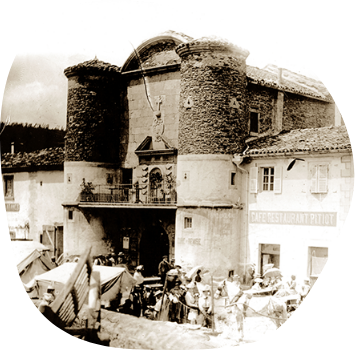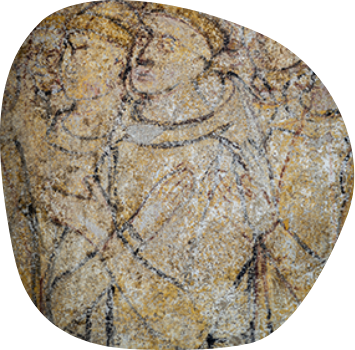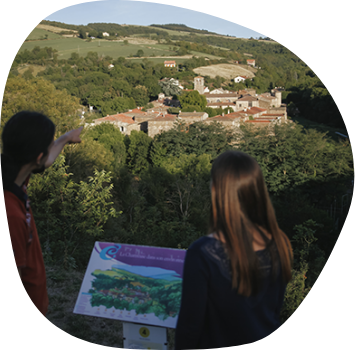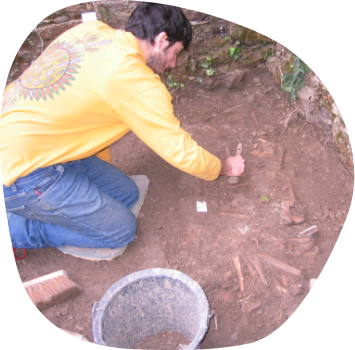History
Discover the centuries-old history of the Site of the Charterhouse in Sainte-Croix-en-Jarez through a few major dates, from its foundation to the present day.
Foundation
The deed of foundation of the Chartreuse was signed in Taluyers on February 24, 1280 (Julian calendar), on the initiative of Béatrix de la Tour du Pin, widow of Guillaume de Roussillon, the lord of the land.
13th century
13th century
Foundation
The deed of foundation of the Chartreuse was signed in Taluyers on February 24, 1280 (Julian calendar), on the initiative of Béatrix de la Tour du Pin, widow of Guillaume de Roussillon, the lord of the land.
Completion of the mediaeval church
The mediaeval church is the oldest building of the monastery that is still visible. It is decorated with murals dedicated to Thibaud de Vassalieu, benefactor of the Chartreuse, who was buried there.
14th century
14th century
Completion of the mediaeval church
The mediaeval church is the oldest building of the monastery that is still visible. It is decorated with murals dedicated to Thibaud de Vassalieu, benefactor of the Chartreuse, who was buried there.
Extension and renovation
The Chartreuse underwent an important transformation phase: the old refectory became a church, the facade was renovated. The configuration of the whole building became the one that is still known today.
17th century
17th century
Extension and renovation
The Chartreuse underwent an important transformation phase: the old refectory became a church, the facade was renovated. The configuration of the whole building became the one that is still known today.
Departure of the monks
During the Revolution, religious congregations were suppressed and the Carthusians had to leave their monastery. Two years later, in 1794, its buildings, which had become a national property, were divided up and sold at auction. They were bought by the inhabitants of the surroundings, who settled there and thus transformed the Chartreuse into a village.
18th century

18th century
Departure of the monks
During the Revolution, religious congregations were suppressed and the Carthusians had to leave their monastery. Two years later, in 1794, its buildings, which had become a national property, were divided up and sold at auction. They were bought by the inhabitants of the surroundings, who settled there and thus transformed the Chartreuse into a village.

Discovery of murals
Hidden under a coating, the painted decorations of the mediaeval church were discovered in 1896 by La Diana Archaeological Society. As the earliest element of the Chartreuse to be classified as a Historical Monument back in 1902, they undergo regular restorations.
19th century

19th century
Discovery of murals
Hidden under a coating, the painted decorations of the mediaeval church were discovered in 1896 by La Diana Archaeological Society. As the earliest element of the Chartreuse to be classified as a Historical Monument back in 1902, they undergo regular restorations.

Creation of the association
The inhabitants united to ensure the preservation and restoration of their heritage. Since its creation, the Association de Sauvegarde et d’Animation de l’Ancienne Chartreuse (Association for the Safeguarding and Development in the Old Chartreuse) has promoted the history and riches of the Site. It also carries out many cultural events: concerts, festivals, shows, exhibitions, fairs…
1977
1977
Creation of the association
The inhabitants united to ensure the preservation and restoration of their heritage. Since its creation, the Association de Sauvegarde et d’Animation de l’Ancienne Chartreuse (Association for the Safeguarding and Development in the Old Chartreuse) has promoted the history and riches of the Site. It also carries out many cultural events: concerts, festivals, shows, exhibitions, fairs…
Most beautiful village in France
Sainte-Croix-en-Jarez was one of the 66 municipalities to first receive the Plus Beaux Villages de France® label (Most Beautiful Villages in France) from its creation – a guarantee of its charm and its commitment to preserving and enhancing its exceptional heritage. More recently, Sainte-Croix-en-Jarez was also recognized as a Village de Caractère en Loire® (Characterful village in Loire).
1982

1982
Most beautiful village in France
Sainte-Croix-en-Jarez was one of the 66 municipalities to first receive the Plus Beaux Villages de France® label (Most Beautiful Villages in France) from its creation – a guarantee of its charm and its commitment to preserving and enhancing its exceptional heritage. More recently, Sainte-Croix-en-Jarez was also recognized as a Village de Caractère en Loire® (Characterful village in Loire).

Discovery of the cemetery
The successive restoration and excavation campaigns until 2007 in the first courtyard and the small cloister led to the discovery of numerous bones in the latter. Most of them were skeletons of monks, more precisely of Brothers buried there from the 16th to the 18th century.
1990

1990
Discovery of the cemetery
The successive restoration and excavation campaigns until 2007 in the first courtyard and the small cloister led to the discovery of numerous bones in the latter. Most of them were skeletons of monks, more precisely of Brothers buried there from the 16th to the 18th century.

The tourism office
The Saint-Étienne Métropole Tourist Office took over from the Association de Sauvegarde et d’Animation de l’Ancienne Chartreuse (Association for the Safeguarding and Development in the Old Chartreuse) to enhance the Site and welcome visitors.
2009
2009
The tourism office
The Saint-Étienne Métropole Tourist Office took over from the Association de Sauvegarde et d’Animation de l’Ancienne Chartreuse (Association for the Safeguarding and Development in the Old Chartreuse) to enhance the Site and welcome visitors.
Restoration of the hermitage
The efforts to enhance the Site went on, with the restoration of a hermitage belonging to Le Pilat Regional Nature Park. The hermitage allows visitors to immerse themselves in the living environment of a Carthusian father.
2021

2021
Restoration of the hermitage
The efforts to enhance the Site went on, with the restoration of a hermitage belonging to Le Pilat Regional Nature Park. The hermitage allows visitors to immerse themselves in the living environment of a Carthusian father.

